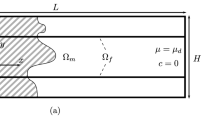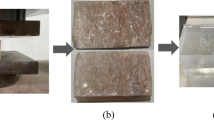Abstract
In this article, transport and retention of nanoparticles that flow in suspension through packed beds with unconsolidated spheres and through consolidated Berea sandstone are numerically explored. The surfaces exhibit electrical charge heterogeneity where particles can deposit blocking the surrounding surface deposition sites. The lattice Boltzmann method with Lagrangian particle tracking are the techniques employed. Four ideal patterns of surface charge heterogeneity are adopted for the packed sphere beds, while a real distribution of charge heterogeneity is determined for the Berea core through micro-CT image segmentation. It is found that particle breakthrough curves do not reach a plateau, unless the pore surfaces are completely saturated. Surface saturation also enhances particle propagation because of the surface blocking mechanism, reducing the effective particle deposition rate. In addition, surface saturation mitigates the effect of the pattern of heterogeneity on particle retention, which might be pronounced when blocking is not taken into account. It is also observed from the case of Berea core that the heterogeneity of the mineralogical surfaces disturbs particle transport depending on the physicochemical properties of the surfaces. Likewise, similarity of the mineralogical surface properties is a prerequisite for the commonly used patch-wise model with Langmuirian blocking to reproduce nanoparticle breakthrough in such porous media.








Similar content being viewed by others
References
Berlin JM, Yu J, Lu W, Walsh EE, Zhang L, Zhang P, Chen W, Kan AT, Wong MS, Tomson MB, Tour JM (2011) Engineered nanoparticles for hydrocarbon detection in oil-field rocks. Energy Environ Sci 4(2):505–509
Matteo C, Candido P, Vera RR, Francesca V (2012) Current and future nanotech applications in the oil industry. Am J Appl Sci 9(6):784–793
Bargozin H, Moghaddas JS (2013) Stability of nanoporous silica aerogel dispersion as wettability alteration agent. J Dispers Sci Technol 34(10):1454–1464
Zaid HM, Yahya N, Latiff NRA (2013) The effect of nanoparticles crystallite size on the recovery efficiency in dielectric nanofluid flooding. J Nano Res 21:103–108
Islam MR (1999) Emerging technologies in enhanced oil recovery. Energy Sources 21(1–2):97–111
Karimi A, Fakhroueian Z, Bahramian A, Pour Khiabani N, Darabad JB, Azin R, Arya S (2012) Wettability alteration in carbonates using zirconium oxide nanofluids: EOR implications. Energy Fuels 26(2):1028–1036
Zhang R, Bai Y, Zhang B, Chen L, Yan B (2012) The potential health risk of titania nanoparticles. J Hazard Mater 211–212:404–413
Colvin VL (2003) The potential environmental impact of engineered nanomaterials. Nature 21(10):1166–1170
Nowack B, Bucheli TD (2007) Occurrence, behavior and effects of nanoparticles in the environment. Environ Pollut 150(1):5–22
Bystrzejewska-Piotrowska G, Golimowski J, Urban PL (2009) Nanoparticles: their potential toxicity, waste and environmental management. Waste Manag (Oxford) 29(9):2587–2595
Johnson PR, Sun N, Elimelech M (1996) Colloid transport in geochemically heterogeneous porous media: modeling and measurements. Environ Sci Technol 30(11):3284–3293
Elimelech M, O’Melia CR (1990) Effect of particle size on collision efficiency in the deposition of Brownian particles with electrostatic energy barriers. Langmuir 6(6):1153–1163
Elimelech M, O’Melia CR (1990) Kinetics of deposition of colloidal particles in porous media. Environ Sci Technol 24(10):1528–1536
Song L, Johnson PR, Elimelech M (1994) Kinetics of colloid deposition onto heterogeneously charged surfaces in porous media. Environ Sci Technol 28(6):1164–1171
Elimelech M, Nagai M, Ko CH, Ryan JN (2000) Relative insignificance of mineral grain zeta potential to colloid transport in geochemically heterogeneous porous media. Environ Sci Technol 34(11):2143–2148
Litton GM, Olson TM (1993) Colloid deposition rates on silica bed media and artifacts related to collector surface preparation methods. Environ Sci Technol 27(1):185–193
Chen JY, Ko CH, Bhattacharjee S, Elimelech M (2001) Role of spatial distribution of porous medium surface charge heterogeneity in colloid transport. Colloids Surf A 191(1–2):3–15
Vaidyanathan R, Tien C (1991) Hydrosol deposition in granular media under unfavorable surface conditions. Chem Eng Sci 46(4):967–983
Qian YH, D’Humières D, Lallemand P (1992) Lattice BGK models for Navier–Stokes equation. Europhys Lett 17(6):479–484
Chen S, Doolen GD (1998) Lattice Boltzmann method for fluid flows. Annu Rev Fluid Mech 30:329–364
Sukop MC, Thorne DT (2006) Lattice Boltzmann modeling: an introduction for geoscientists and engineers, 1st edn. Springer, NewYork
Voronov RS, VanGordon SB, Sikavitsas VI, Papavassiliou DV (2010) Distribution of flow-induced stresses in highly porous media. Appl Phys Lett 97(2):024101
Voronov RS, VanGordon SB, Sikavitsas VI, Papavassiliou DV (2011) Efficient Lagrangian scalar tracking method for reactive local mass transport simulation through porous media. Int J Numer Methods Fluids 67(4):501–517
Voronov R, VanGordon S, Sikavitsas VI, Papavassiliou DV (2010) Computational modeling of flow-induced shear stresses within 3d salt-leached porous scaffolds imaged via micro-CT. J Biomech 43(7):1279–1286
Lubachevsky BD, Stillinger FH (1990) Geometric properties of random disk packings. J Stat Phys 60(5):561–583
Pham NH, Swatske DP, Harwell JH, Shiau B-J, Papavassiliou DV (2014) Transport of nanoparticles and kinetics in packed beds: a numerical approach with lattice Boltzmann simulations and particle tracking. Int J Heat Mass Transf 72:319–328
Papavassiliou DV (2002) Scalar dispersion from an instantaneous line source at the wall of a turbulent channel for medium and hight Prandtl number fluids. Int J Heat Fluid Flow 23(2):161–172
Kontomaris K, Hanratty TJ (1992) An algorithm for tracking fluid particles in a spectral simulation of turbulent channel flow. J Comput Phys 103(2):231–242
Tufenkji N, Elimelech M (2005) Breakdown of colloid filtration theory: role of the secondary energy minimum and surface charge heterogeneities. Langmuir 21(3):841–852
Ko CH, Elimelech M (2000) The “shadow effect” in colloid transport and deposition dynamics in granular porous media: measurements and mechanisms. Environ Sci Technol 34(17):3681–3689
Song L, Elimelech M (1993) A collection of papers presented at the international symposium on colloids in the aquatic environment, organized by SCI and surface chemistry groupdynamics of colloid deposition in porous media: modeling the role of retained particles. Colloids Surf Physicochem Eng Aspects 73:49–63
Johnson PR, Elimelech M (1995) Dynamics of colloid deposition in porous media: blocking based on random sequential adsorption. Langmuir 11(3):801–812
Yilmaz N, Bakhtiyarov AS, Ibragimov RN (2009) Experimental investigation of Newtonian and non-Newtonian fluid flows in porous media. Mech Res Commun 36(5):638–641
Churcher PL, French PR, Shaw JC, Schramm LL (1991) Rock properties of Berea sandstone, Baker dolomite, and Indiana limestone. Paper presented at the SPE International Symposium on Oilfield Chemistry, Anaheim, CA
Nemati M, Voordouw G (2003) Modification of porous media permeability, using calcium carbonate produced enzymatically in situ. Enzyme Microb Technol 33(5):635–642
Einstein A (1905) The motion of elements suspended in static liquids as claimed in the molecular kinetic theory of heat. Ann Phys (Leipz) 17(8):549–560
Mostaghimi P, Bijeljic B, Blunt M (2012) Simulation of flow and dispersion on pore-space images. SPE J 17(04):1131–1141
Van Brakel J (1975) Pore space models for transport phenomena in porous media review and evaluation with special emphasis on capillary liquid transport. Powder Technol 11(3):205–236
MacDonald RA (1988) Computer model of a porous medium. Int J Thermophys 9(6):1061–1069
Satterfield CN (1970) Mass transfer in heterogeneous catalysis. MIT Press, Cambridge, Massachusetts
Bradford SA, Simunek J, Bettahar M, VanGenuchten MTH, Yates SR (2003) Modeling colloid attachment, straining, and exclusion in saturated porous media. Environ Sci Technol 37(10):2242–2250
Xu S, Gao B, Saiers JE (2006) Straining of colloidal particles in saturated porous media. Water Resour Res 42(12):W12S16
Sun Y, Gao B, Bradford SA, Wu L, Chen H, Shi X, Wu J (2015) Transport, retention, and size perturbation of graphene oxide in saturated porous media: effects of input concentration and grain size. Water Res 68:24–33
Xin J, Tang F, Zheng X, Shao H, Kolditz O (2016) Transport and retention of xanthan gum-stabilized microscale zero-valent iron particles in saturated porous media. Water Res 88:199–206
Wang JG, Li Y, Fortner JD, Hughes JB, Abriola LM, Pennell KD (2008) Transport and retention of nanoscale C60 aggregates in water-saturated porous media. Environ Sci Technol 42(10):3588–3594
Javadpour F, Farshi MM, Amrein M (2012) Atomic-force microscopy: a new tool for gas-shale characterization. J Can Pet Technol 51(04):236–243
Dahneke B (1974) Diffusional deposition of particles. J Colloid Interface Sci 48(3):520–522
Brenner H (1961) The slow motion of a sphere through a viscous fluid towards a plane surface. Chem Eng Sci 16(3):242–251
Acknowledgments
This work has been partially supported by the Advanced Energy Consortium (http://www.beg.utexas.edu/aec/), Project BEG08-022. Member companies include Petrobras, Statoil, Shell, and Total. Part of this work was done while DVP was serving at the National Science Foundation (NSF). Any opinion, findings, and conclusions or recommendations expressed in this material are those of the authors and do not necessarily reflect the views of the NSF. The use of computing facilities at the University of Oklahoma Supercomputing Center for Education and Research (OSCER) and at XSEDE (under allocation CTS-090025) is also gratefully acknowledged.
Author information
Authors and Affiliations
Corresponding author
Rights and permissions
About this article
Cite this article
Pham, N.H., Papavassiliou, D.V. Nanoparticle transport in heterogeneous porous media with particle tracking numerical methods. Comp. Part. Mech. 4, 87–100 (2017). https://doi.org/10.1007/s40571-016-0130-7
Received:
Revised:
Accepted:
Published:
Issue Date:
DOI: https://doi.org/10.1007/s40571-016-0130-7




